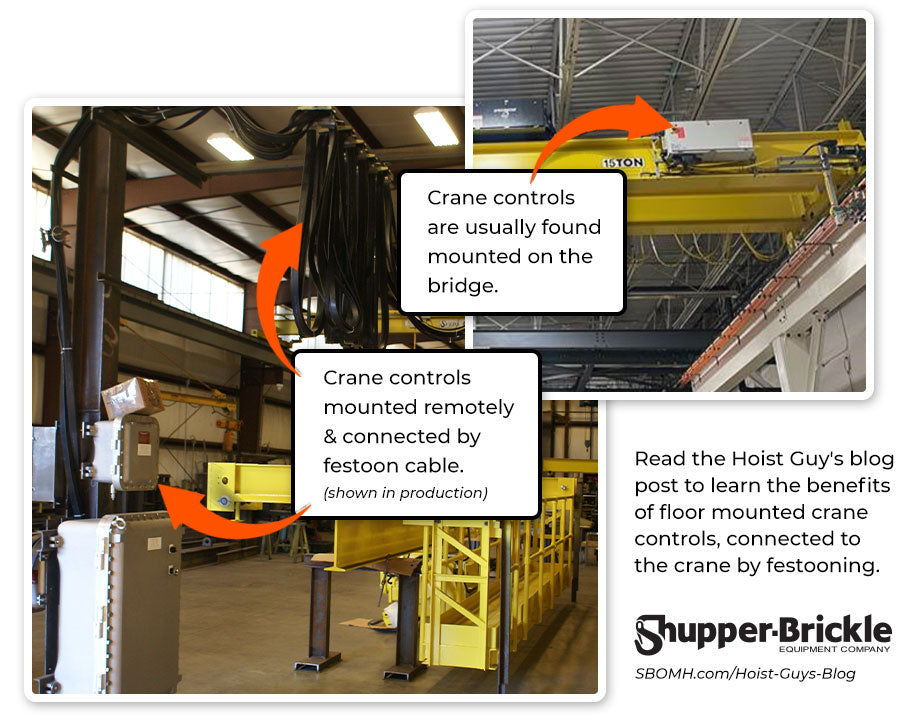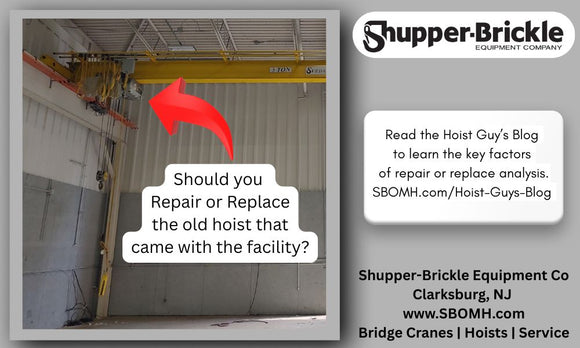
Pros and Cons of customized Floor level controls for your overhead lifting system
Andrew T. Litecky
Welcome to the Hoist Guy’s Blog, where our resident hoist guy, Andrew T. Litecky, shares his experience customizing overhead lifting systems and discusses the pros and cons of locating bridge crane controls at the floor level.
Crane Control Location Options
When purchasing a new bridge crane overhead lifting system for your facility, it’s common practice to mount the control enclosure on the bridge. This is most economical in the short-term and the default design of most overhead traveling cranes. However, you should consider floor-mounted controls for practical benefits and long-term savings.
Floor-Mounted Bridge Crane Controls
The option of floor-mounted bridge crane controls is often overlooked but has many benefits. This setup provides ease of maintenance, with all controls in an easy to reach location, and your plant electrician and maintenance technician will immediately see the advantages. They will no longer require a scissor lift to access the control panel or need to clear the production floor to park the scissor lift. While this feature will enhance your PM program, it adds to the initial cost of the crane system. Like any variation to the basic design, there are pluses and minuses to consider.
Standard Crane Electrification & Controls
The electrification of a standard crane mounted control panel for an overhead lifting system is four bar: L1, L2, L3 and ground. Sliding shoe collectors are mounted on the bridge structure, and electricity is fed from the bars to the collectors, and power is brought into the panel. Bridge, hoist and trolley crane power is delivered through the collector bars. The control enclosure in this configuration is mounted on the bridge. All maintenance activities, from changing a blown fuse to replacing a VFD or contactor, would be done at the crane elevation, and wherever the bridge stopped along the runway. From an initial cost, this is the most economical configuration. From a maintenance point, unless you have a walkway across the bridge, this is usually the least convenient.
How Floor Mounted Bridge Crane Controls Work
Mounting the controls for an overhead lifting system at floor level requires that all electrical connections be landed on terminal strips in junction boxes at several locations. All electrical enclosures, except for the main floor level control enclosure, will have terminal strips for power and control for the crane, hoist and trolley. Along the runway, festooned cables run for power to the crane motors, hoist and trolley (these are heavier gauge flat wires) and control wires for the crane motion and the hoist and trolley functions. The electrical conductors are fed from a junction box at the end of the runway. From the runway junction box, all conductors are run through conduit to the main control panel located at floor level.
Floor Mounted Crane Controls – Return on Investment
The initial investment of the festooned conductors and the labor required to run the wires through the conduit is higher than mounting the controls on the bridge and delivering the power to the crane through conductor bars. However, the return on investment happens when something in the bridge, hoist or trolley panel needs attention and the electrician must trouble shoot the system, looking for reasons why the crane stopped working. Trouble shooting your overhead lifting system at 20’ or 25’ above the floor on a scissor lift is not as safe or effective as looking for a problem at floor level. Over time, the floor level mounted panels save time and money and will reduce maintenance costs.
Cost Savings for Explosion-Proof Applications
For explosion-proof applications, we found cost-savings in remotely mounting bridge crane controls for one customer’s location. In this recent crane application, a Class I, Division 2, Group C & D hazardous location, the main control enclosure was mounted in a non-hazardous area located nearby and at floor level. The customer realized a major cost savings by using non-hazardous controls, and this offset the extra cost of remote mounting the controls.
Contact Shupper-Brickle for Customized Bridge Cranes
Since 1969, Shupper-Brickle Equipment has provided customized overhead material handling equipment. Contact us for engineered systems and comprehensive services in the Mid-Atlantic states.


